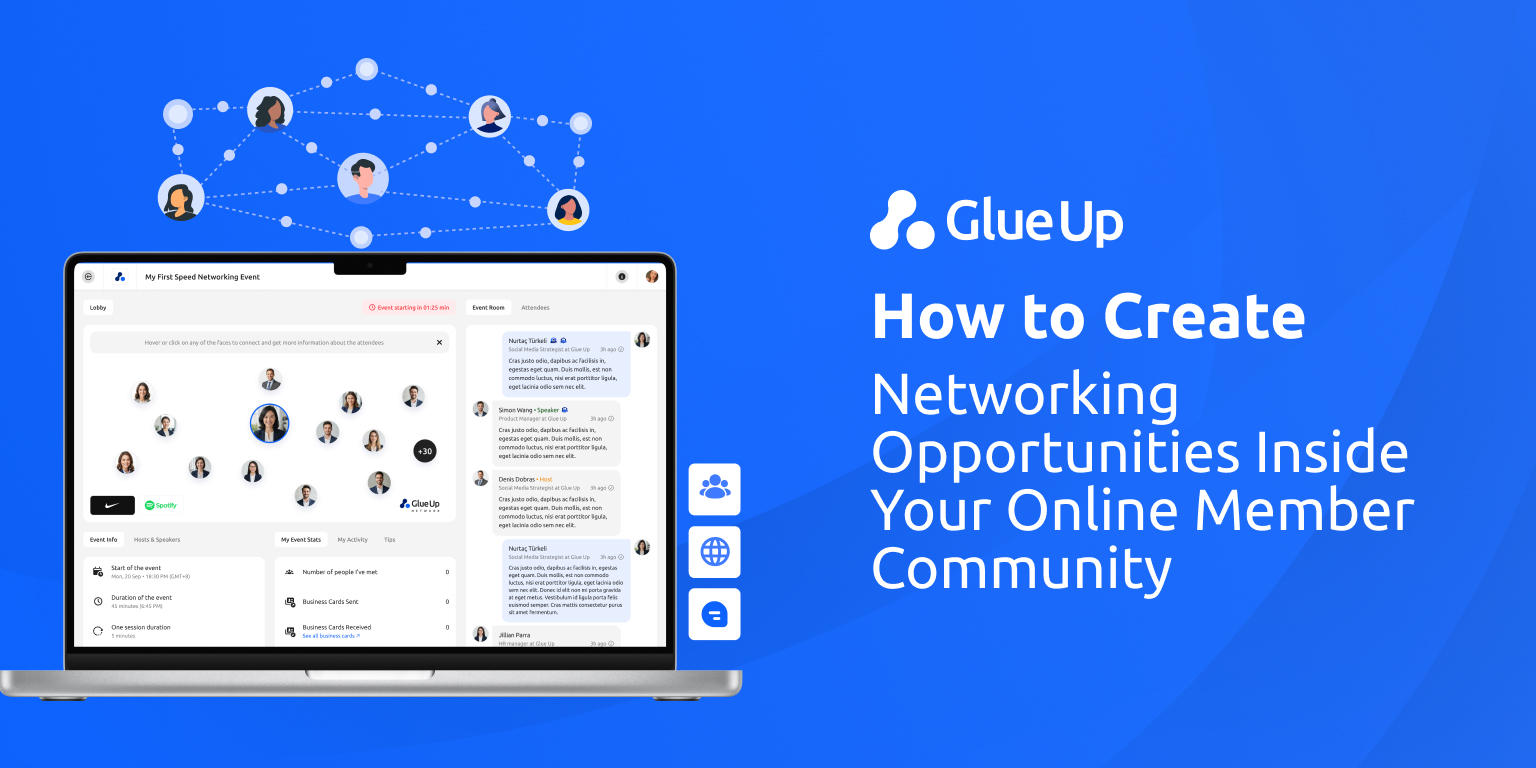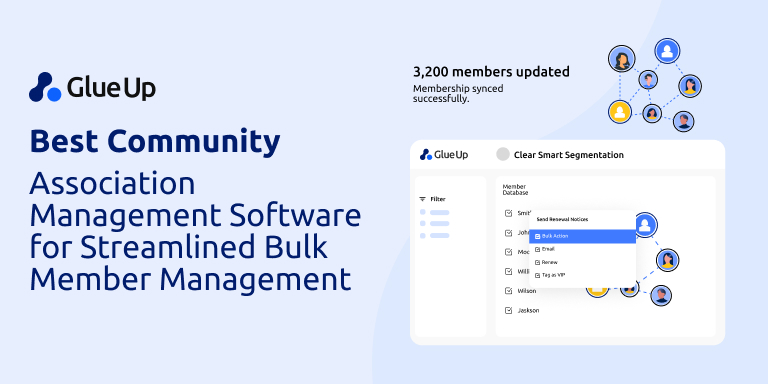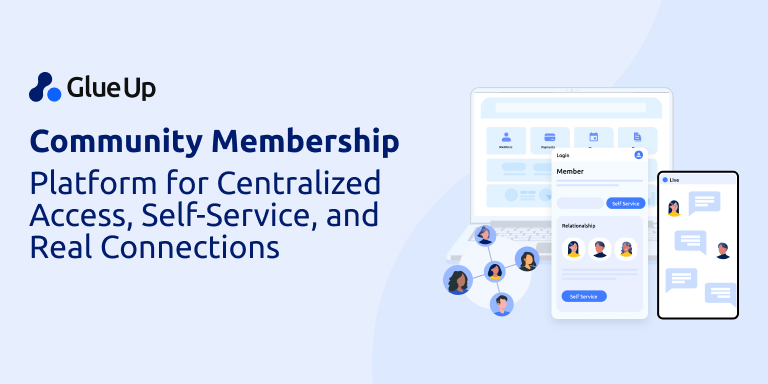
Online communities have become an integral part of our social fabric. People from all walks of life come together to share ideas, collaborate on projects, and build connections. This sense of community is especially important for associations, where members share a common interest or goal.
However, not all online communities are created equal. Private online communities, with their exclusive nature, offer unique advantages that can greatly benefit your associations and members.
In this article, we will explore the power of exclusivity and delve into why private online communities matter for associations.
We will also learn:
- The 7-step process of building & growing your private community
- Advantages of private online communities
- And how you can improve engagement within your community
But first…
What are Private Online Communities?
Private online communities are digital platforms or networks where a group of individuals with shared interests, experiences, or goals can come together to communicate, collaborate, and interact with each other.
These communities are typically "private" in the sense that they are not open to the general public. Joining them require an invitation, application, or subscription, and members often agree to a specific set of rules or guidelines to ensure a respectful and supportive environment.
Private online communities could exist on various online platforms, including social media networks, forums, group messaging platforms, or dedicated community platforms. They provide members with a sense of belonging, mutual support, and a safe space to share and discuss their thoughts and ideas.
Difference Between Private Online Communities and Public Communities
To understand the differences better, you need to understand them separately first:
Private Online Communities
- Only people who meet the criteria set by the community can join.
- An admin might reach out, or you can find it and apply.
- All the information shared is inaccessible to anyone outside.
- Members are involved in and engage in high-quality discussions.
- Private communities are easy to manage and moderate.
- Bottomline: Members only.
Public Communities
- Open to all.
- Even if they have guidelines, they aren’t that rigid.
- While only members can participate in the discussions, everyone can access them.
- Owing to the size of the virtual community, they’re hard to moderate.
There are two major differences. One is the entry criteria. And the other is moderation.
Why are Private Online Communities Created?
I. To Offer Exclusivity
Private communities often provide exclusive content, resources, or insights that are not accessible to the general public. This could include premium articles, industry reports, expert interviews, or behind-the-scenes information.
By offering unique and valuable content, the community enhances its appeal and distinguishes itself from public platforms.
II. Create a Safe Space for Members
Private online communities make sure that only your members are able to join the group.
They also prioritize member privacy and ensure that personal information is protected. You can employ secure login systems, encrypted communication channels, and robust data protection practices to safeguard member data.
Read more: How to Increase Data Security and Personalization for Greater Member Loyalty?
Thus, members feel more comfortable sharing and engaging in discussions when they trust their personal information is being handled with care.
III. Develop Long-Lasting Bonds
As these communities cater to a very niche group of people interested in something common, they have high-quality discussions that foster better relationships between the members. This results in enhanced user experience and better community engagement.
Read more: 8 Ways to Use Content to Acquire and Engage Your Members
Building and Growing a Private Online Community
Most private online communities follow a set process to ensure that they create a safe and secure place for the members.
Here are the main steps they follow when building a private online community:
Step 1: Defining the Objective
The number one step for building a private community is laying down the main goal. Make sure you have a clear, common goal that’ll bring all your members together.
Step 2: Choosing the Right Platform
The next step, one of the most important, is picking a reliable and secure online platform or support to help you create a private community. When choosing the platform, remember these points:
- Is it customizable?
- Is it scalable?
- Does it comply with the data protection laws?

Glue Up is one such software that meets all three criteria mentioned above. Designed exclusively for member-based organizations, this private online streamlines community engagement and foster meaningful connections among your members.
The community offers extensive features like discussion forums, chatrooms, and member directories to facilitate collaboration, advice-seeking, and problem-solving. Its intuitive interface and robust analytics allow community managers to monitor and measure the success of their engagement strategies, offering insights that can help shape future initiatives.
Furthermore, its customizable nature allows you to tailor it according to the unique requirements of your private community, thereby promoting a more immersive, interactive, and productive online environment. Thus, you can create a cohesive community experience, improving overall member engagement and satisfaction.
To learn more about the software and its capabilities, you can get a demo here.
Step 3: Setting the Parameters For the Members
Now that you have your objectives in place and have decided upon a suitable platform, create joining criteria for the community. This is the precise point that makes private online communities exclusive – the deciding criteria for the member pool.
You have the option to open the community to all your members or limit it to a particular membership tier. Alternatively, you can tailor a community specifically for coordinating an event or accomplishing a designated objective.
Step 4: Building a Community Structure
After establishing the entry criteria for members, you need to create a system or the foundation on which the community will be developed.
Work on the guidelines, write down the different roles and responsibilities, establish moderation policies, the kind of content allowed, and so on. You need to list all the rules each virtual community member must follow.
Step 5: Inviting Your Members to Join
Now that everything is in place, you must get the ball rolling. You do this by inviting some people from the core group who have a common interest to join the group.
They might even be the key stakeholders of the community’s main goal.
You can send them personalized invitations or catch potential members' eyes with the help of various marketing channels such as content marketing, social media, email marketing, and so on.
Read More: How to Write a Compelling Membership Invitation Email [with Samples, Examples & Templates]
Step 6: Ensuring Privacy and Security

Safety is a key concern for members of private online communities since they don’t wish their confidential information to get out. So you must ensure that your chosen platform provides extensive privacy and security features.
You need to instill confidence in your members that protecting their sensitive information is a priority, and investing in a good and safe platform is the number one way to do so.
Only once you do so will they feel comfortable sharing and collaborating with the other members.
Step 7: Consistently Enhancing the Member Experience
Communities thrive when their members feel heard. When running a private community, you need to be very vigilant about taking feedback from the members and working on improving their experience.
As your community grows, you must learn how to evolve with them to remain relevant and reliable. You can only do this by working on the feedback you receive from them.
Another thing you must remember when building private online communities is encouraging participation. There are several ways in which this can be done – offer valuable insights, start discussions, and ask members to share their experiences.
These steps will give you a general idea of how to go about setting up your virtual community. But you can customize them to suit your unique needs.
Benefits of Private Online Communities
Now let’s discuss the top advantages of such communities:
i) Get a competitive edge with exclusive insights: Such virtual communities help build a link between the members and the real people of your organization.
While these communities serve many purposes for the organization (content creation, marketing intelligence, etc.), they enhance the overall experience for the members. These communities can help you stand out from your peers.
ii) Generate more leads: This is one of the best ways to create more leads. Communities put you on the map, make it easier for you to be discovered, and you can start offering members a valuable service from the get-go.
A well-designed website with a great user experience is crucial to turn leads from your community platform into sales.
iii) Forge meaningful connections: These communities help create meaningful bonds between the members and the organization's people. Members can post their questions, tag other people, and get the answers they’re looking for.
The main part is that they get a sense of belonging – connected to something that’s much bigger than themselves.
iv) Save both time and money: Aside from fostering positive communication, these private online communities encourage people to help themselves by seeking the answers to their questions. This helps organizations save money on transactional and customer support calls and lightens the pressure on the customer support team.
Since people exchange problems, solutions, new ideas, and expert articles, members struggling to find help can search for the answers themselves.
Adding Value To Your Community

As a leading organization in your industry, adding value is crucial for generating high engagement levels within online communities. Here are some key strategies to consider:
a) Share what the audience wants without expectation: Don’t be impatient while building your online community; give as much value to the audience by:
- Solve queries they might have through comments on their posts.
- Create short-form daily content (text or video) sharing helpful insights.
- Write in-depth blog posts with good titles to make sure they go ahead and read them.
In simple words, deliver a lot of value to your audience.
b) Showcasing firm credibility: Share a valuable product and industry knowledge to position the firm as a trusted source of information, capturing attention and establishing thought leadership.
c) Highlighting organizational achievements: Share firm milestones, successful partnerships, or awards to foster a sense of pride, excitement, and shared accomplishment among community members.
d) Seeking opinions and feedback: Encourage active participation by asking thought-provoking questions, conducting polls, and seeking input on new initiatives or products. This creates a sense of ownership and strengthens the firm's and community members' bond.
e) Sharing promotions and exclusive offers: Reward community members with special discounts or access to exclusive content, making them feel appreciated and fostering a sense of exclusivity and belonging.
f) Consider the growth stage of the community: The impact of different post types on engagement is particularly significant in early-stage communities, diminishing as the community matures. Adapt and tailor post content to the evolving needs and interests of the community as it grows.
The private online community is all about developing a space where your members can forge meaningful connections with each other and connect on a deeper level with your organization. Such communities can grow into long-lasting relationships that result in greater brand loyalty and open the doors for endless opportunities for all your community members as well as your organization.
For more insights on building an online community, explore these valuable resources, or feel free to reach out to us here
Author Bio

Mayank Singh is the founder of the Website Times. He helps businesses increase their online revenue by making highly optimized websites.



